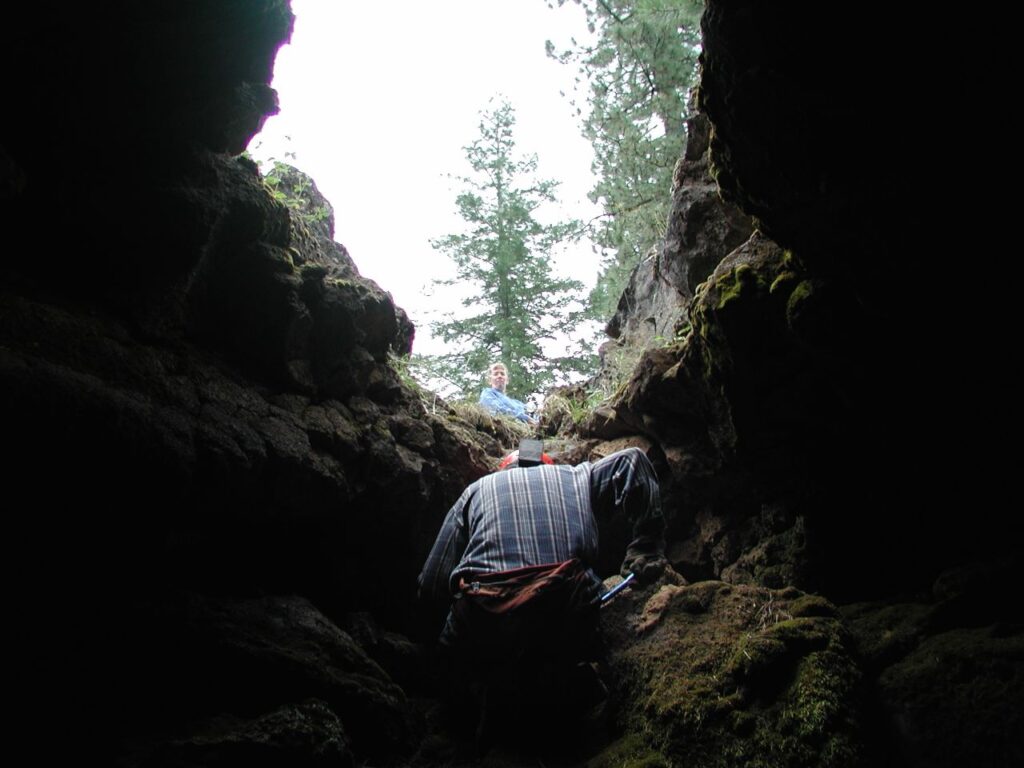Pre-History of the Shasta Area Grotto (SAG):
Far northern California had few cavers and was an area of seemingly unlimited potential, before SAG was formed. A loose association of six National Speleological Society (NSS) cavers who called themselves the Gaping Holes Gang, based in McCloud, CA was the nucleus for SAG. This group was active between 1979 and 1982, when SAG was formed. There was never a newsletter of the Gang, but an official t-shirt was created in late 1980 or early ’81. Talk of forming an NSS chartered grotto began with the addition of some cavers from Redding.
The growth of SAG and local interactions:
An initial meeting, attended by 12 cavers, was held during February 1982 in Redding to work out a charter and bylaws for the NSS, and we officially became NSS grotto 289 in March of 1982. The first organized grotto trip was to Samwel Cave on Shasta Lake. A newsletter called the SAG RAG was started later in 1982 and continues to this day. The grotto grew quickly. Cavers from the coast to the Nevada border, and from Chico to southern Oregon joined up. Meetings were held all over the north state. An annual cave conservation weekend was instituted for February which came to include three cave clean ups and a ski trip.
Involvement with other caving groups:.
In 1990 SAG members led cave trips during an NSS convention in Yreka, where we gained some new members. SAG has hosted three Western Region meetings and five April Under-Earth trips. We have cooperated with nearby grottos on cave mapping and management projects. Several SAG members are active with Cave Research Foundation (CRF) projects in the Lava Beds and other places.
Educational programs:
Bats have interested many local organizations, Garden clubs, schools, and California State Parks. All have requested bat and/or cave programs. SAG members have given programs, and led trips for these groups for many years. Private land owners have asked for caves to be mapped or bats identified. Early on we worked with The Nature Conservancy to map some caves they own on the McCloud River.
Involvement with Government Entities:
SAG is uniquely placed in an area where 95 percent of the caves are on Federal lands. SAG has cooperated with five national forests, the Bureau of Land Management, Caltrans, Fish and Wildlife, and two national monuments. We have helped the forests and BLM learn about their caves and how to manage them. We have surveyed, inventoried, described and helped them understand the caves that underlie their forests. We have built bat gates to protect maternity and hibernating colonies of bats. A few SAG members have taken part in National Fish and Wildlife programs on caves and the life in them. We have successfully helped Caltrans work up a bat friendly bridge design for day and night roosts. Many days of hard labor have been put in at Oregon Caves and Lava Beds National Monuments in restoration projects. Other conservation efforts have included working with an environmental company on a trench for a buried cable. This project gave us a chance to amaze the crews by fitting into ?too small? spaces with ease, and allowed us to have talks with some of the local Native Americans about our conservation ethics and any artifacts we may find in the caves. In return for our efforts and hard labor SAG has been awarded several certificates of Merit as well as garnering a nomination for a national award. SAG annually trains with the Siskiyou Search and Rescue (SAR) group in cave rescue techniques, teaching in-cave travel techniques and running a realistic scenario to test their skills.
Summary:
Our main interest was, and still is, caving. Over the years people with varied interests have joined the grotto. These interests include cave management and protection, photography, archaeology, bat studies, survey, cartography, restoration, expedition caving, inventory, and rescue and vertical training with Siskiyou SAR. We have gone from being a small group with narrow interests, to a small group with a broader view of our role in the caving scene.
